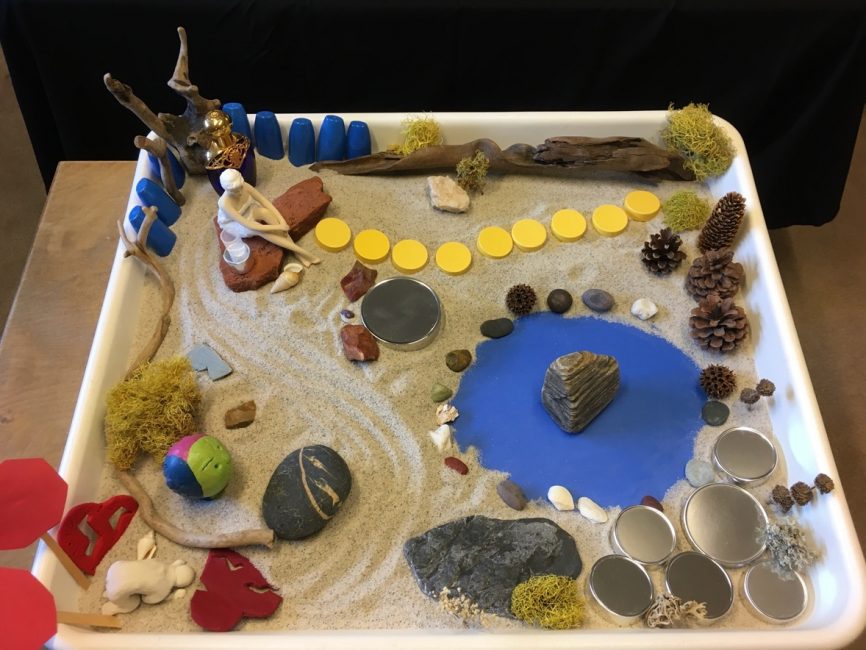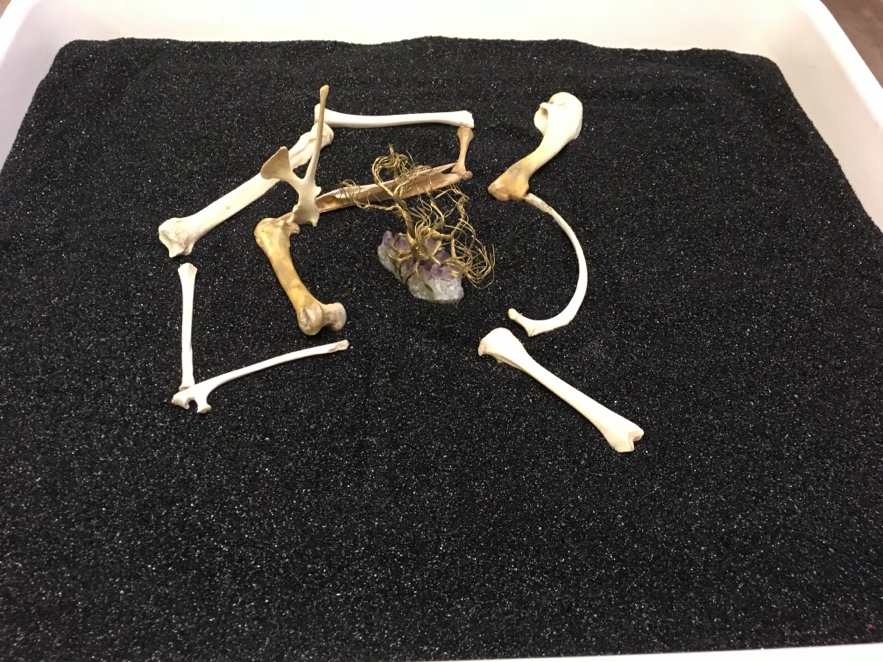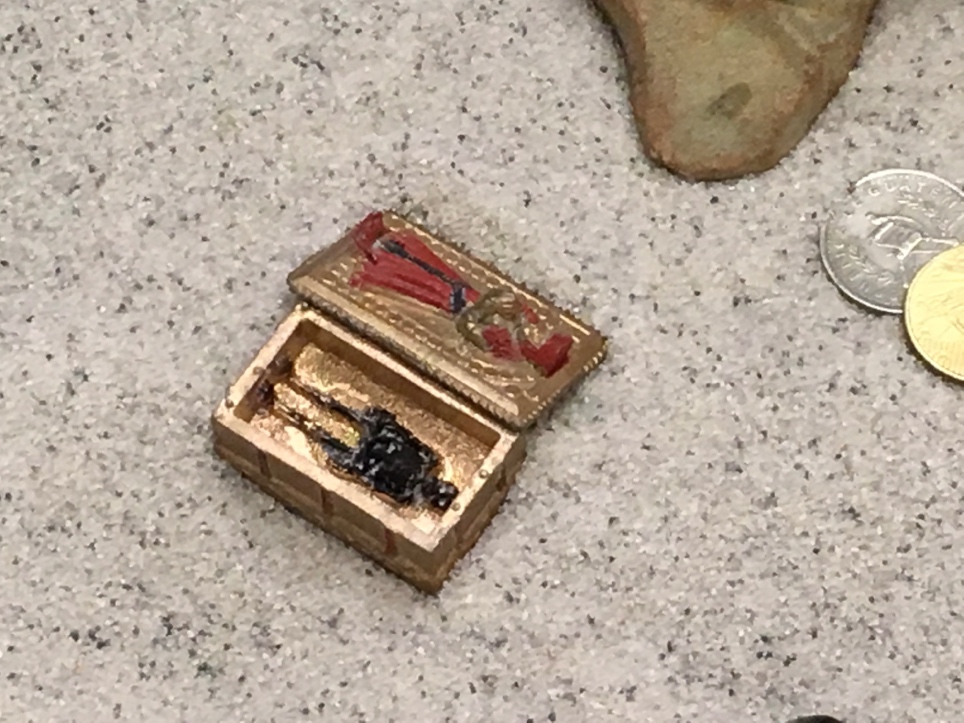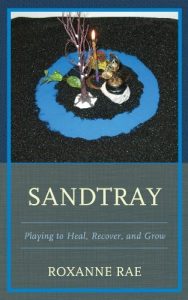Figure 1
I am continuing this chat to aid the novice and entice those therapists uncertain about venturing into using Sandtray methods. Please feel free to contact me if you need clarification or have a question about the material in these blogs (no fee involved).
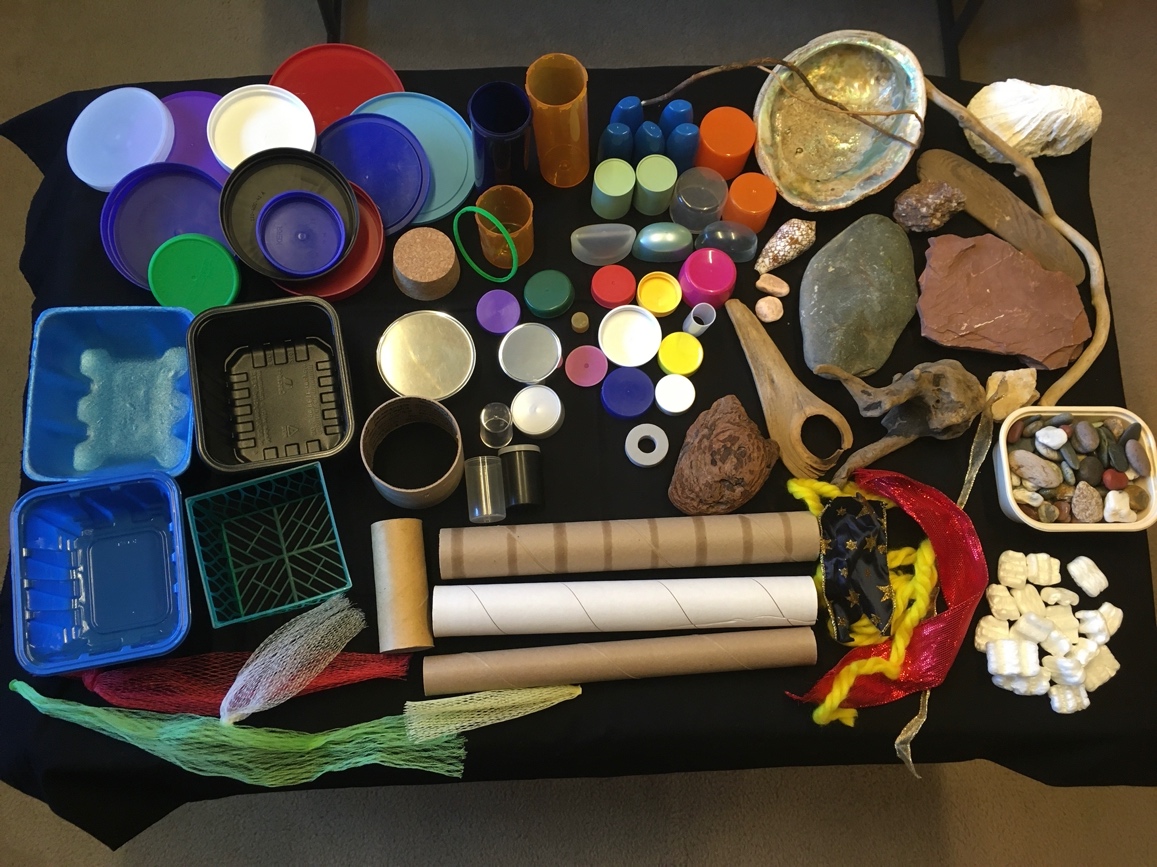
Figure 2
The most often voiced deterrent to Sandtray is the belief that one must spend thousands of dollars to acquire an adequate collection of miniature items for this approach to be effective. This belief is a myth. A variety of free and inexpensive pieces can exponentially expand your collection (figure 2). The sand, water, and miniatures are all used to express oneself. It is not just single items, but the combinations that may be formed with multiple pieces like those shown. It is true that my current Sandtray collection is extensive, which makes the example below even more poignant. Note also that in the introductory photo above, there is only a single piece that was purchased (figure 1). Even during my meager beginnings, my clients demonstrated profound abilities to explore, express, and transform their life experiences despite my very basic tools.
Before I go on to the logistical/practical part of what I initially planned to present, I will share what occurred while I was preparing this blog:
I had previously started a Sandtray for the purpose of demonstrating that the use of free objects can be beneficial for the world creator. I was interrupted just as I started, and that became serendipitous. My initial image was to create two distinct areas in the sand, delineated by hills or mountains. After forming these in sand, I set a blue plastic lid near the NE corner of the tray. That was as far as I got.
The next day I began again with more protected time, so that I could better access my right (less cognitive) brain functions. As is my method, this tray was not “thought out” using my cognitive (left brain) form of thinking, I let it just emerge. I am sharing a portion of my own internal process with you since it highlights how effective free objects are in facilitating the Sandtray technique. I again felt the need to form two separate places in the tray that I later referred to as “the cage” and “the oasis.” After forming the dry sand, I started in the NW corner with the bamboo skewers, water bowl (a blue lid), driftwood, and a rock. I knew that this was forming a boundary but not for whom. My thought was that an animal might go in there. I did not know the qualities of this “fence” that I had put up (figure 3).
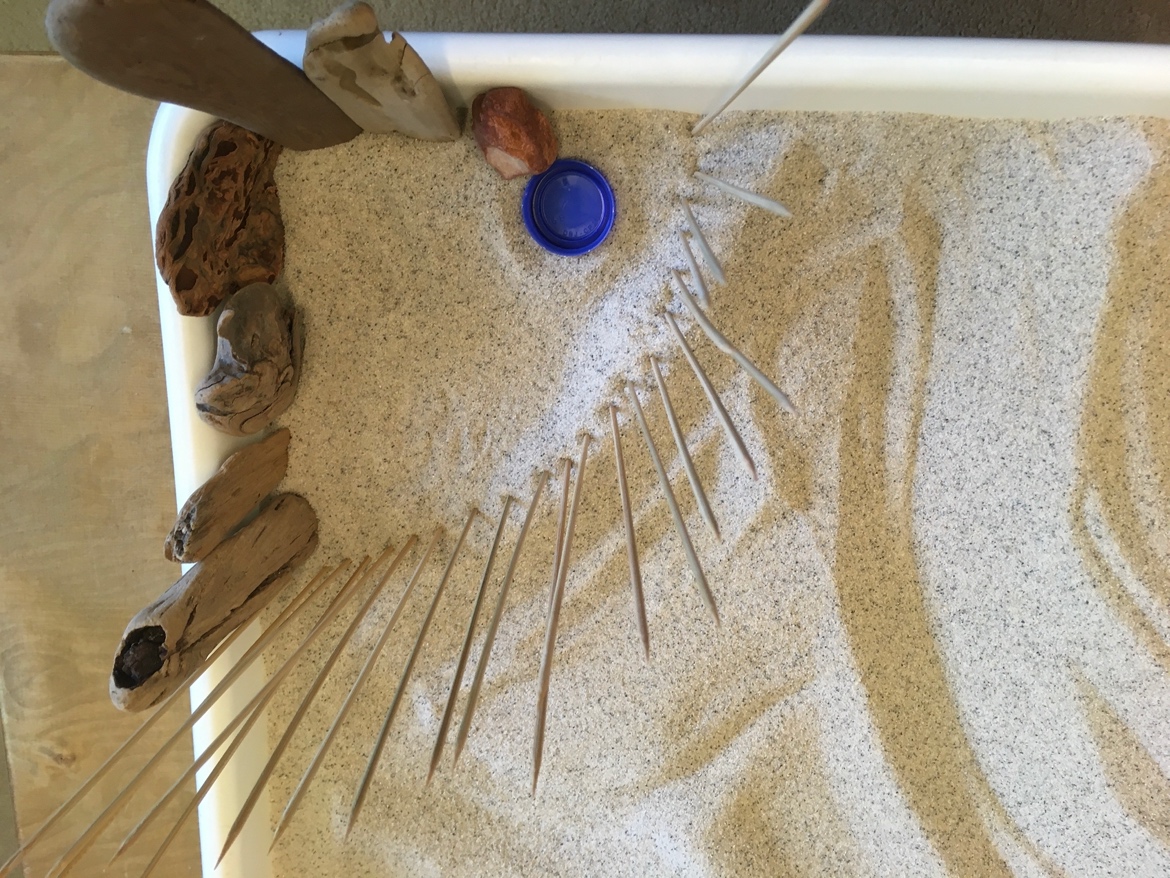
Figure 3
I then placed the same blue lid used the previous day toward the NE corner as a pond. Somehow, I just knew (heart knowing) that it must go there. Making minor reformations to the sand, I added the pinecones just east of the ridge of the mountains and placed two skinny pinecones in the corner, but that wouldn’t do. The large pinecone was placed in the corner, and the others moved aside. It was at this point that the thought, “This is an oasis” came to me. I “decorated” my oasis with additional items and reflected on what I had created (figure 4).

Figure 4
I added more embellishments to the oasis area (figure 5). While reflecting I recognized that the two marbles were about play. I could never have an oasis without playfulness! As I looked back at the cage, I noticed that it was tall and menacing, but also permeable. I was not moved to place a figure inside of it. I felt the inspiration to link these two areas, and formed a tunnel with a cardboard cylinder, sand, and rocks. At this point—solidifying a pathway between the cage and the oasis, a huge wave of relief came over my body and physical tension dissipated within a few minutes. Then I noticed that my sand formation had other “roads” or “paths” that linked the cage and the oasis areas. I augmented a part of the tray with a piece of obsidian rock, which links to fun times in my childhood, and added more greenery (figure 5).
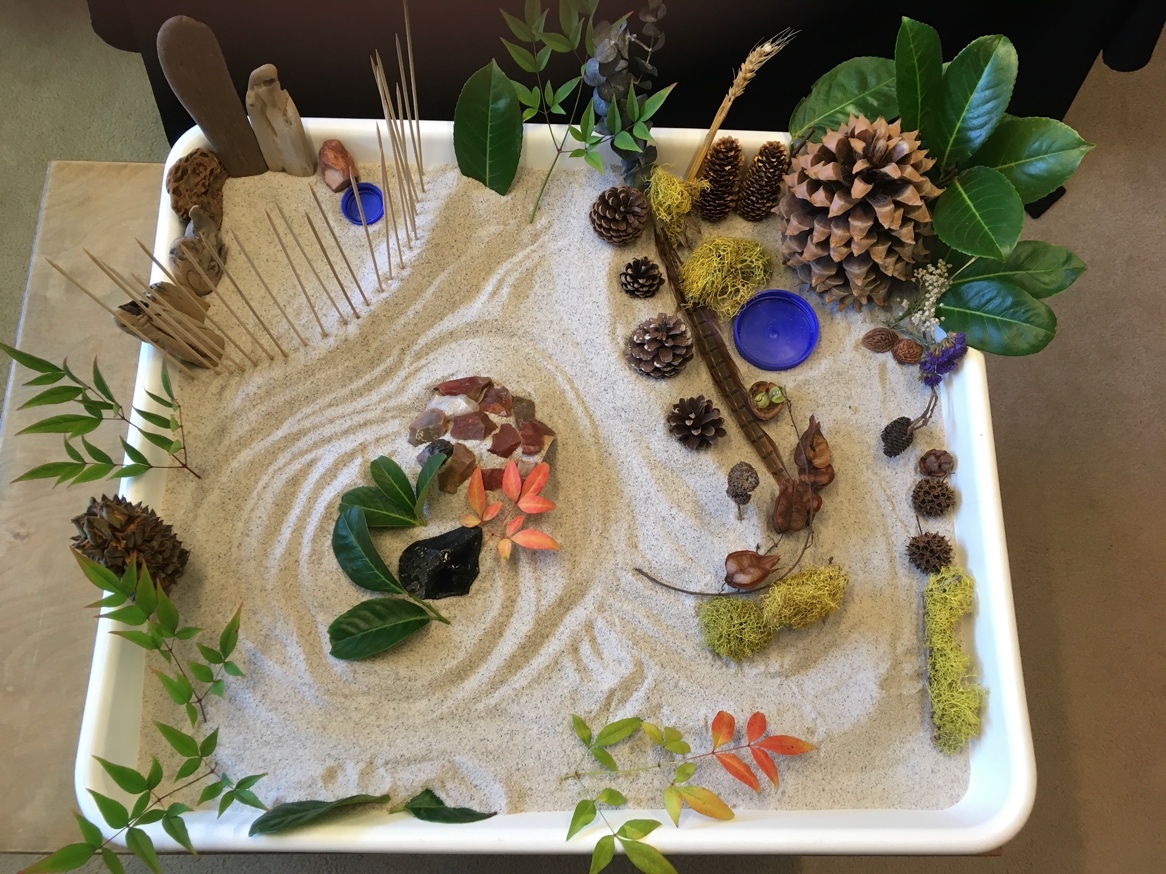
Figure 5
Some personal reflections about this work:
I discovered that the two experiences of being caged and resting in the oasis were not really separate, had multiple ways to communicate, and any path taken to the oasis offered beauty. Movement from a sense of being caged to the oasis had clearly opened in my body and my psyche. In addition, I could literally see that from a particular place in the cage it appeared that the only path, should I be able to escape, would be to squeeze through this tiny tunnel and risk rocks falling in on me (figure 6). This becomes my point of view when my perspective is ridged or stuck. Now I can readily see how to move from a cage experience to that of an oasis. Some further work will be to recognize the reverse: How is it that I get myself into that caged state? What habits support that function, and what are my other options to stay out of that ridged stance? Sandtray does offer us endless options for growth. I’m working on it!
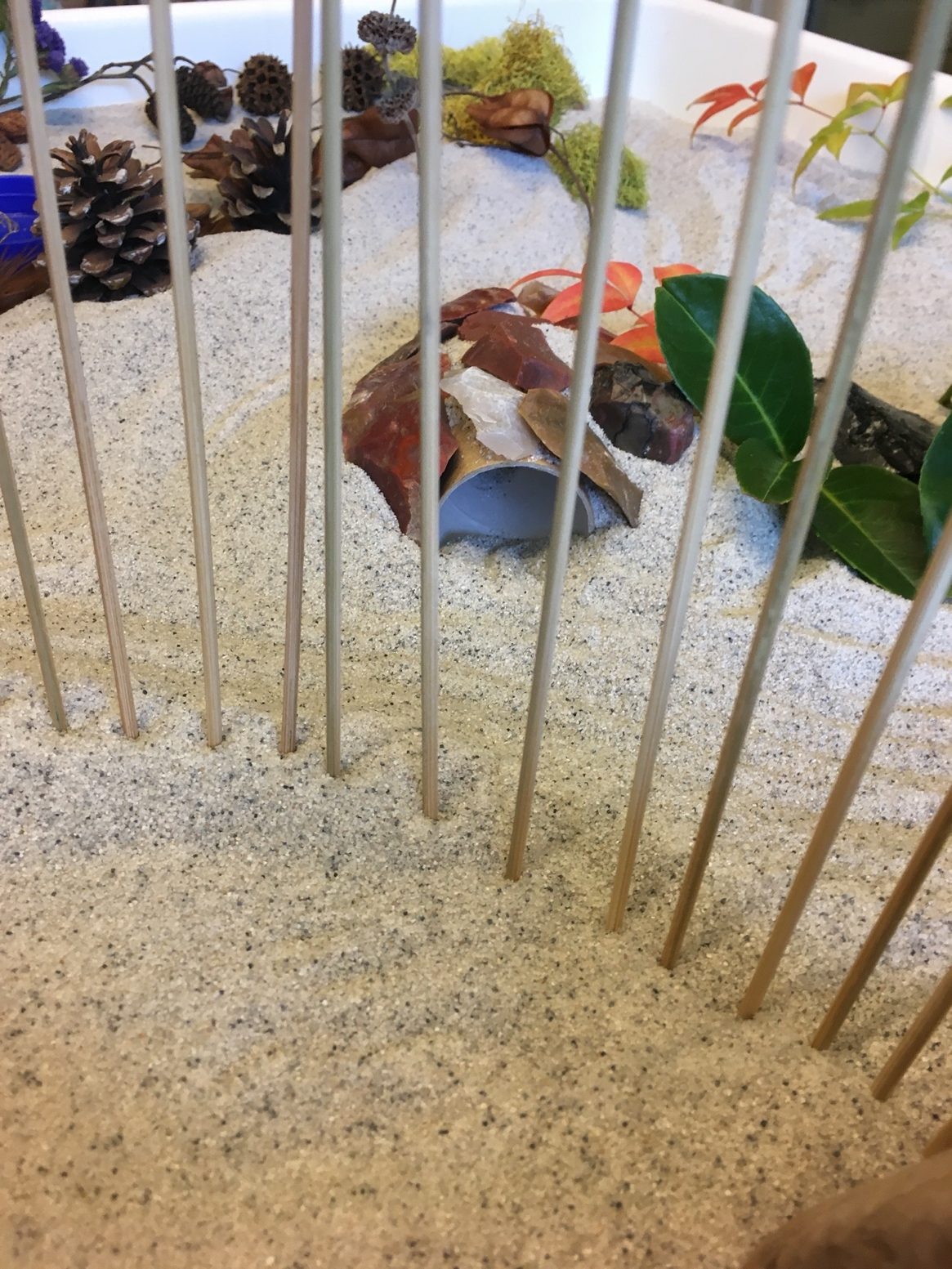
Figure 6
Back to more basics…
It is easiest to start collecting free stuff. Please look closely at the photos in this blog and see what kinds of items may work. Begin to look around you. Imagine how everyday items, often discarded ones, may be cleaned and used in a Sandtray. Lids, bins, rocks, sticks, moss, feathers, shells, etc. Consider the list below and gather what is easiest. Again, I encourage you to play with what you find. Styrofoam mushroom containers can be pools, but also cut for rivers, backdrops, clouds, etc. Containers from salad and spinach can become bins for miniatures, gathering baskets, or buildings (placed upside down, and doors and windows can be cut into them). Real plants may be trimmed, washed, and dried to provide trees or bushes. If kept in water some of these will last for weeks. Your collection will grow faster if you enlist the aid of family and friends.
It is my hope that play therapists living in different places will communicate through such sites as the Association for Play Therapy’s discussion digest. People could share their free resources and exchange what is readily available in their environment, and receive what is not.
During my early days I bought double bags of soldiers and spray-painted half of them. I also saved bones from chicken/turkey dinners. I sprayed some of the wish bones gold and others silver. I collected inexpensive bags of items such as animals and pre-historic peoples. Dollar stores are a collector’s friend. At garage sales and thrift stores I found unusual or special items along with bargains. I am not shy about Sandtray. When I explained to yard sale hosts why I needed their discarded items to help people heal, many offered to donate items that did not sell by the end of the day. This was very useful when I was collecting for a non-profit clinic and could offer a tax receipt.
Another less expensive way to expand your collection is to make items. I am a poor artist but created miniatures that have lasted decades. One of my earliest pieces was a three-color head depicting a sad face with tears, an angry face, and a happy face formed in unfired clay and painted. Tattered hearts and a huddled person were made from Sculpy. Stop signs were formed with construction paper (see figure 1). Eventually colleagues with more skill either gifted or allowed me to purchase their creations, such as the plaster-of-Paris pyramids. I am not adverse to scrounging. The gold finial shown was being discarded by friends from their old curtain rod so, of course, I asked for it. The white shapes below are Styrofoam packing (figure 7).
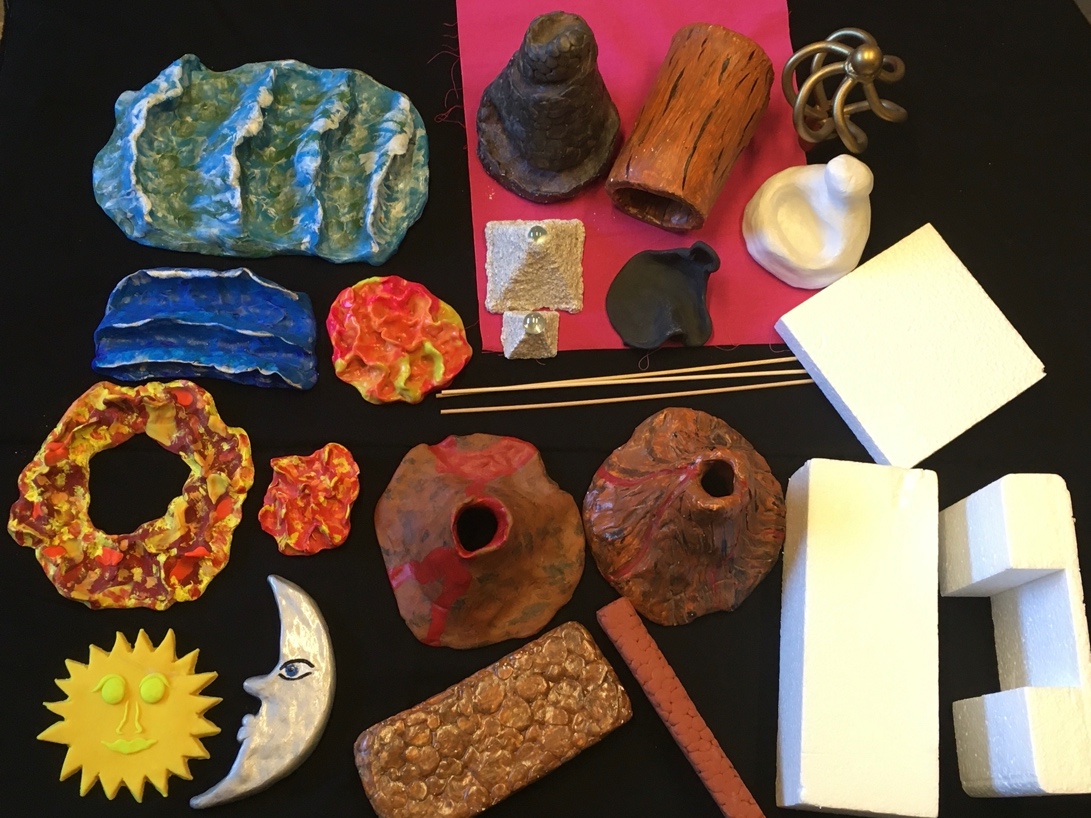
Figure 7
In my playroom I keep Sculpy and other art supplies available. I have engaged in making many kinds of volcanos, often working on anger with clients. This actually started because the purchased volcano in my collection didn’t have a hole in the top—completely unacceptable to my client. Back drops are useful and some items that have been used in this way are shown (figure 8). Construction paper and file folders are also effective tools in creating just the right backdrop for a particular client.

Figure 8
The List
No list of Sandtray miniatures could ever be complete. I only offer a guideline as a basis for ideas. Therapists need to provide a variety, not just a quantity of objects. Clearly, multiple trees are required for a forest and a battle may demand many soldiers. I have had a child ignore my plastic and metal soldiers and create an army made from packing pellets. He drew detailed faces on each fighter with a Sharpie.
Although most items are about six inches or smaller, I do not limit my collection to this scale. Sometimes a client craves a big experience, and a larger object would express this best. Eventually choose items that are made out of various substances such as: resin; bone; plastic; wood; ceramics; metal; glass; and any other substance that will not crumble into the sand. It can be challenging to create a flying or hanging experience. In my commercial offices I used fine wire and elastic lengths on hooks made from paperclips or Christmas ornament hooks that were attached to the false ceilings. I have used “fishing rod” set ups and a kitchen banana hanger as well. Currently, I’ve set up plastic staples recommended by my hardware store.
Elements: Natural and artificial: sea shells; coral; sea environments; rocks; precious gems; crystals; geodes; fire or light sources; water; lakes; rivers; waterfalls (blue and black Styrofoam containers that mushrooms are sold in, and planter saucers); cotton balls; plastic ice and snow. Items that depict/indicate air or wind are used as well.
Plants: It is important to depict various types, seasons, and sizes of trees, bushes, leaves, and flowers. Provide items that depict different aspects of plant-life cycles including: seeds; roots; fruit; flowers; leaves; dried twigs; mosses; pine cones and pods; and full-grown plants. Some larger artificial trees can be up to 14 inches tall.
Animals: Land, air, and sea: domestic and wild; real; extinct; and those of fantasy; alive and dead; mythical and allegorical. Also needed are items that can be used to form animal environments and habitats. Natural or artificial bones; antlers; shells; feathers; eggs or preserved animals are useful.
People: Include people alone and together; of different ages; sizes; sexes; engaged in various activities and occupations; of different cultures; races and time periods; mundane appearing people as well as those from fantasy; myth, and religion. Provide people demonstrating emotions, such as suffering and rejoicing; people who are alive or dead; ancient or modern; miniature human body parts or tiny broken dolls. Various babies are needed, from tiny to 2 inches high and doll-house people of various races/cultures.
Human Environments: Everything people use or create: miniature household items; food; doll-house furniture; books; all items of daily life; buildings and habitats of various cultures; communities and historical-time periods; including science fiction and fantasy; bridges; roads; walls; fences; road and other signs; all transportation in various cultures; land, air, water, outer space, emergency vehicles; and mass transit. Provide “match box/hot wheels” scale fire; rescue; police; tow trucks; construction; and other vehicles.
Miscellaneous: Objects that make a noise, have a scent, have various textures/weights, move or indicate movement in any fashion, those objects that reflect or illuminate. Objects that may be associated with physical, sexual, and substance abuse, healing, communication, the cosmos, the passage of time (syringes w/o needles, chains, marbles, hour glass), religious objects from all religions/cultures over the history of human kind and into its future. Popsicle sticks; toothpicks; Styrofoam pellets; cardboard centers from toilet paper, towel, wax paper, tin foil, and plastic wrap, and unusual items may also be useful.
Preparation of Materials:
- Driftwood/deadfall: wash, simmer in vinegar water for 15 minutes, rinse and dry completely in the sun.
- Pods, moss, etc.: Shake off dust, spray with Lysol. Leave in a sealed plastic bag (I double it) for 3 days. Air out in the sun to remove the fragrance.
- Rocks: rinse off well outside, put in dishwasher to clean. This does not work and is contraindicated for sandstone and other crumbly stones.
- Thrift store/ yard sale items: wash and dry thoroughly.
- Remember that in the beginning it may be necessary to try spray or hand painting items to provide various skin tones, colors, the appearance of gold, silver, etc. Sculpy and clay are readily used to create your own items.
- Plastic or glass food containers of various sizes and shapes (butter; yogurt; baby food; pudding; etc.) will need thorough cleaning and degreasing. These may be used as scoops, molds, candle holders, pedestals or anything a player can dream up.
Displaying Your Collection:
Your display of miniatures should suit your space and style. This is why I do not follow any prescribed method of presenting Sandtray items. You need to be able to find pieces that a Sandtray creator may request, as well as keep your items from becoming chaotic. I use a combination of open shelves, bins, drawers, and baskets. None of my eight offices were arranged just the same.
Some therapists may need to keep their collections (or portions of it) in a cart, trunk, or plastic drawers on wheels to be brought into the therapy space as desired. The trunk shown below was built with drawers inside (figure 9). For traveling therapists or those needing to contain their collection, plastic zipper bags are a lighter weight option. The closet for multiple sand tray storage was created for the Dream Defenders program (see my blog on Children’s Grief). This design is useful for an agency setting with multiple play therapists (figure 10). I would recommend putting more space between the shelves so that damp or wet sand can dry more effectively.
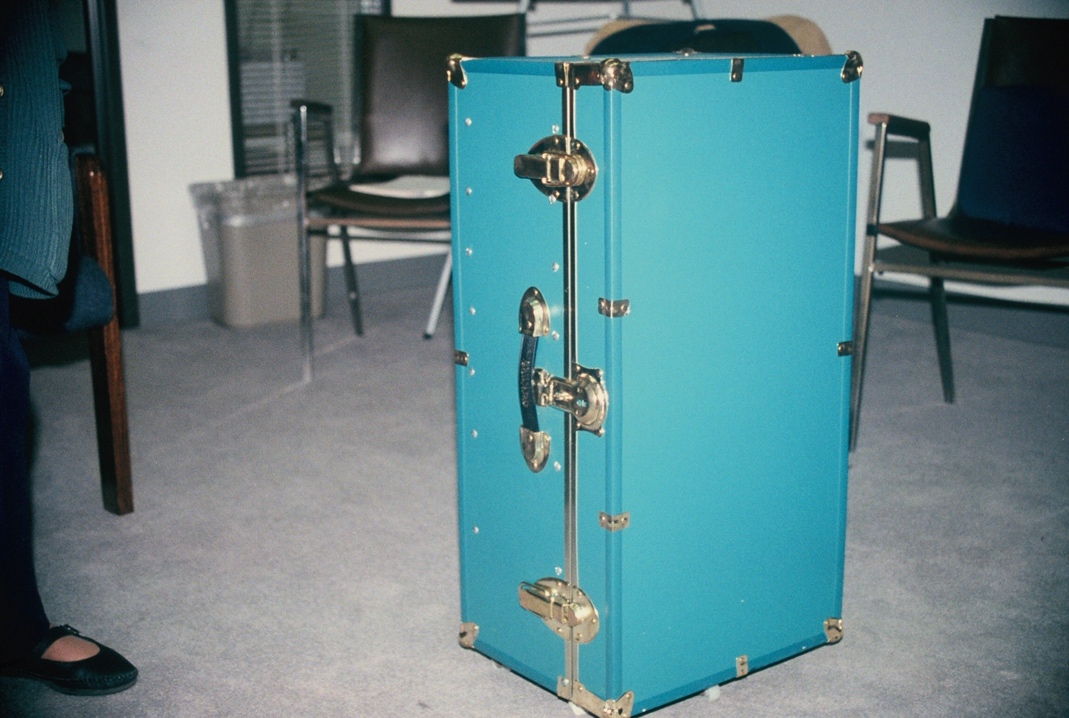
Figure 9
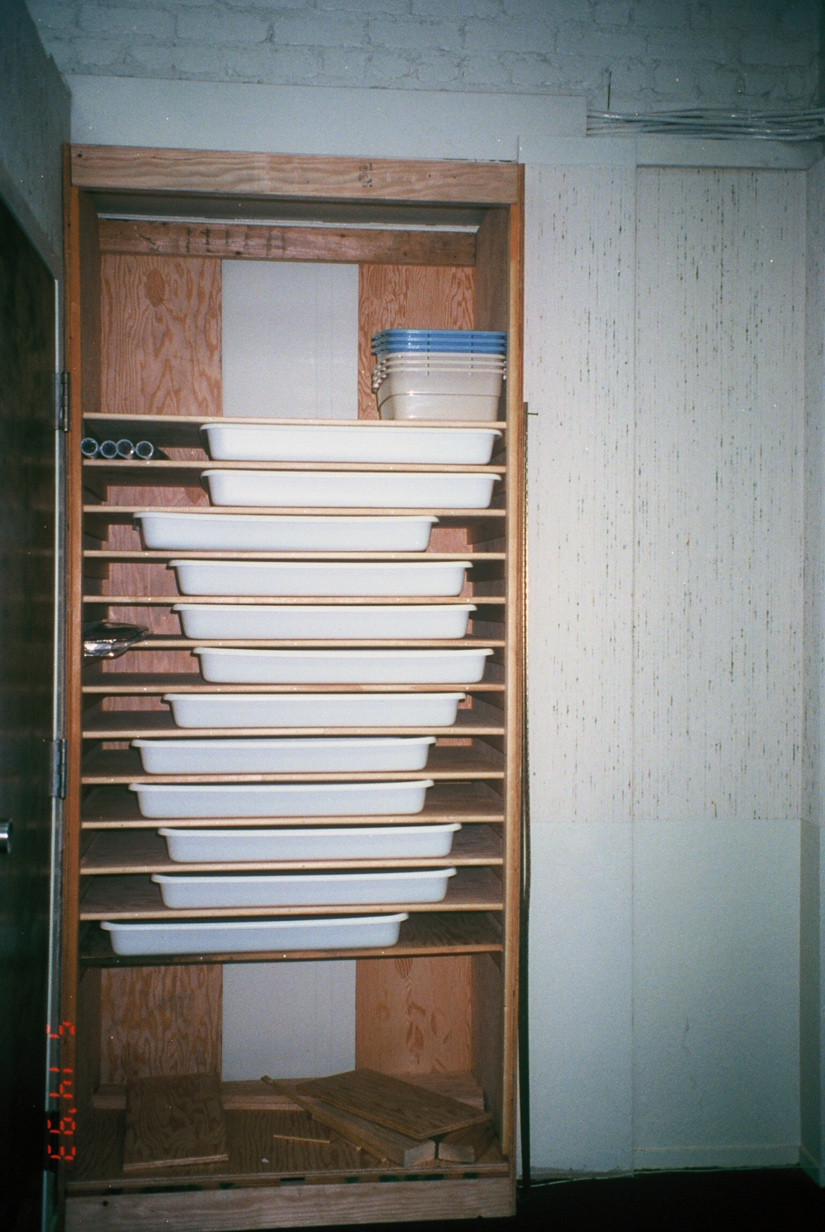
Figure 10
I do place bins of unbreakable items, ready for dumping, low and accessible to children. I have some of my collection in categories (buildings; rocks; shells; trees, flowers; animals; vehicles; etc.), and others readily visible on shelves (figure 11 & 12). As my collection grew, the need for categories and bins increased. Remember that the number of miniatures in my collection were required for offering workshops where as many as 18 individual sand trays were made at one time. A much smaller offering will be fine for an individual play therapy practice. Below I offer some images to aid your imagination.
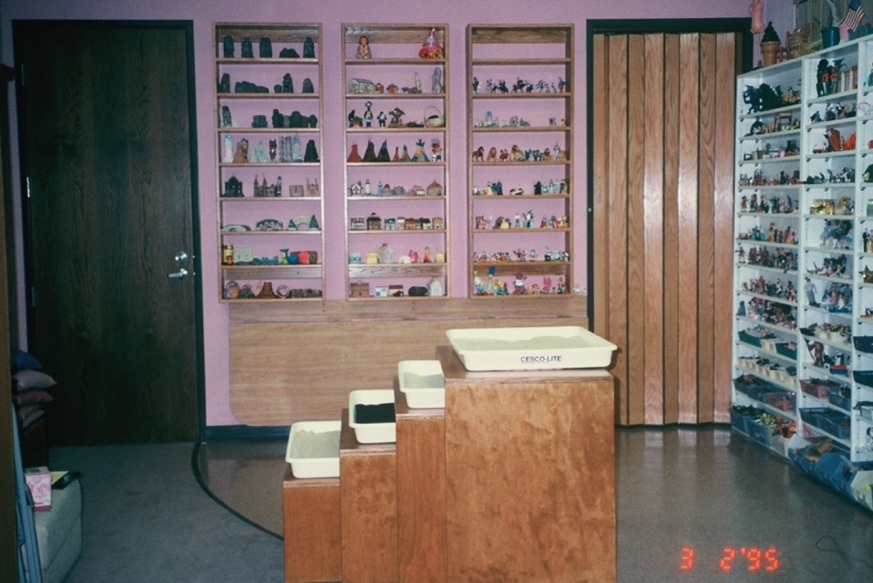
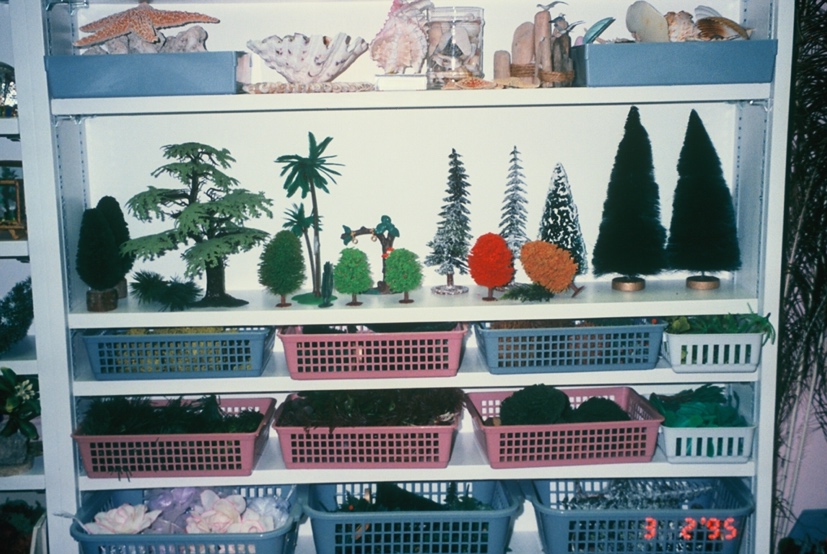
Figures 11 & 12
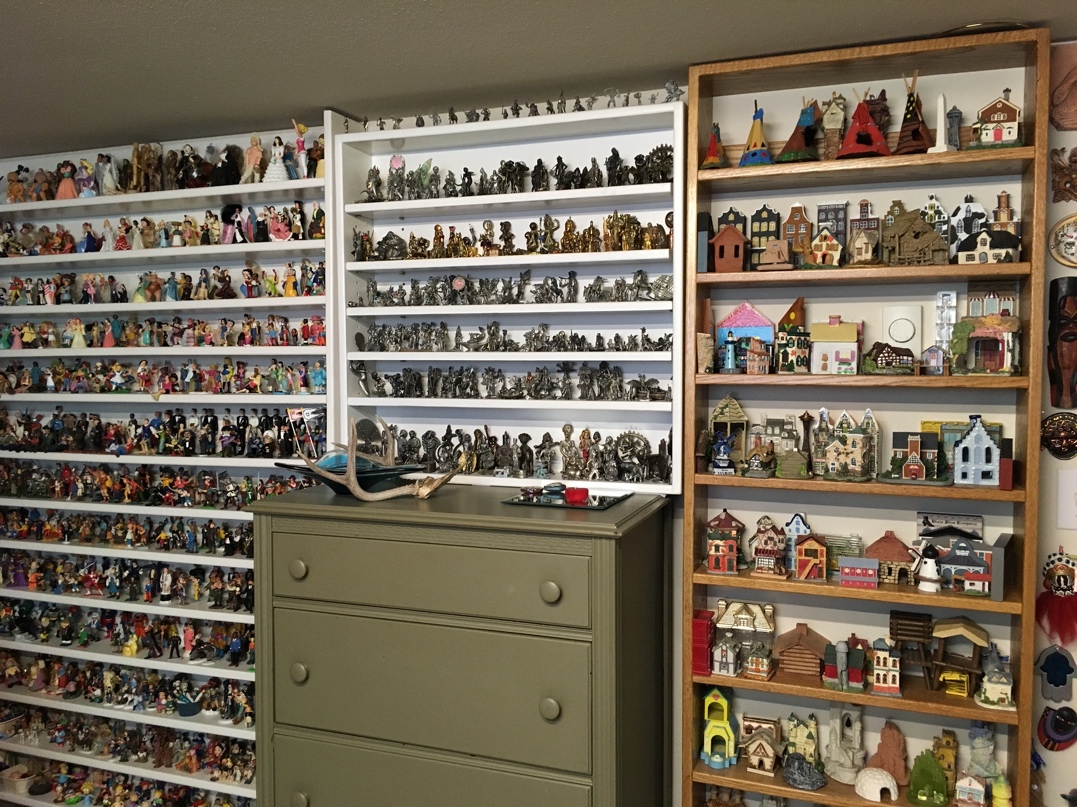
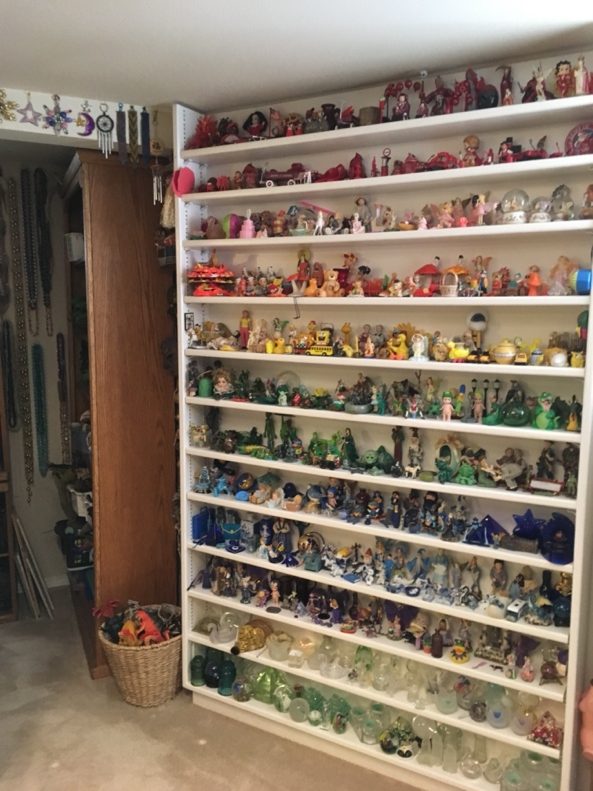
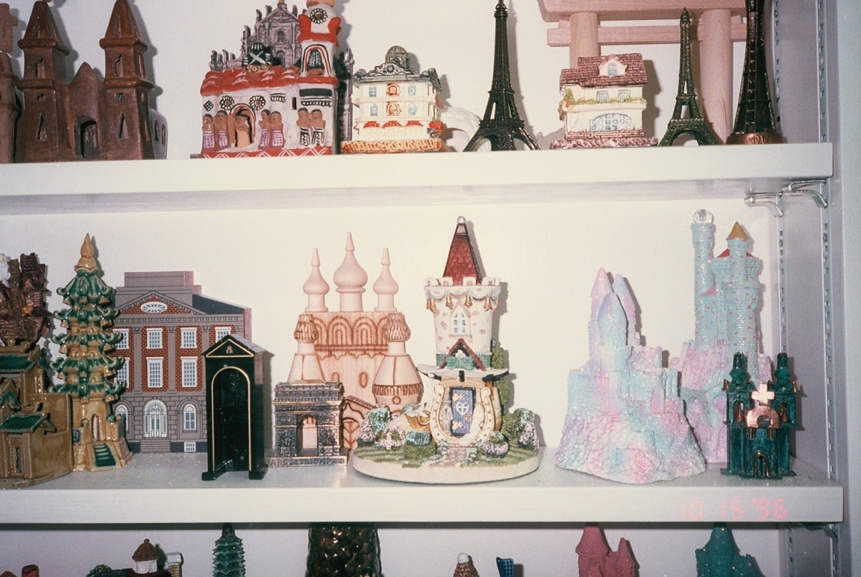
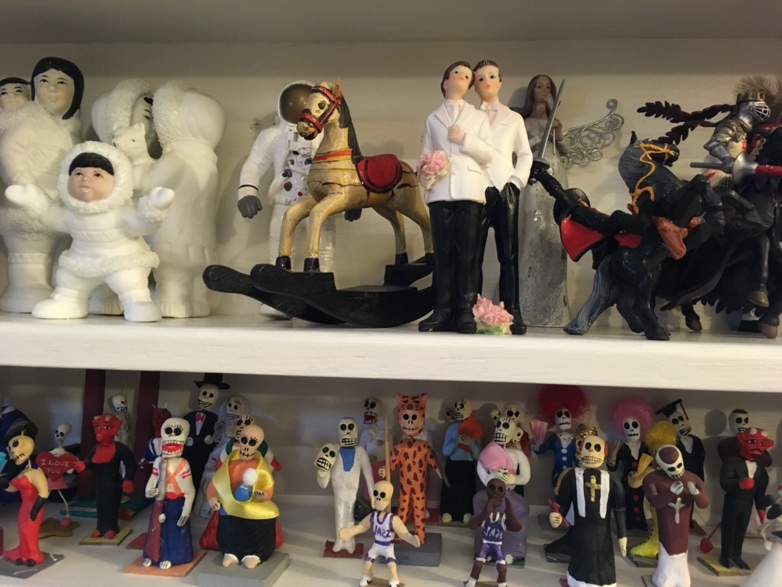
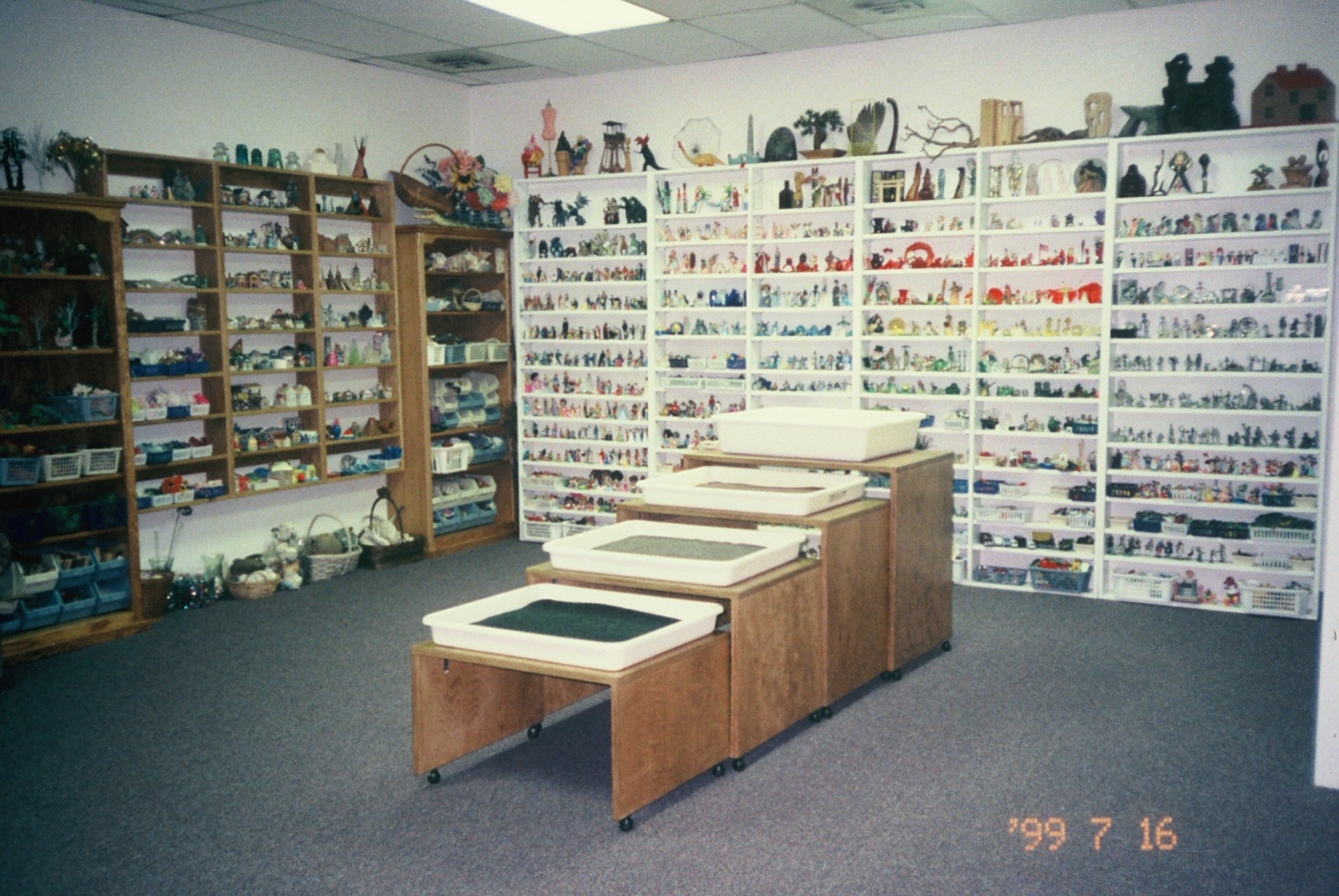
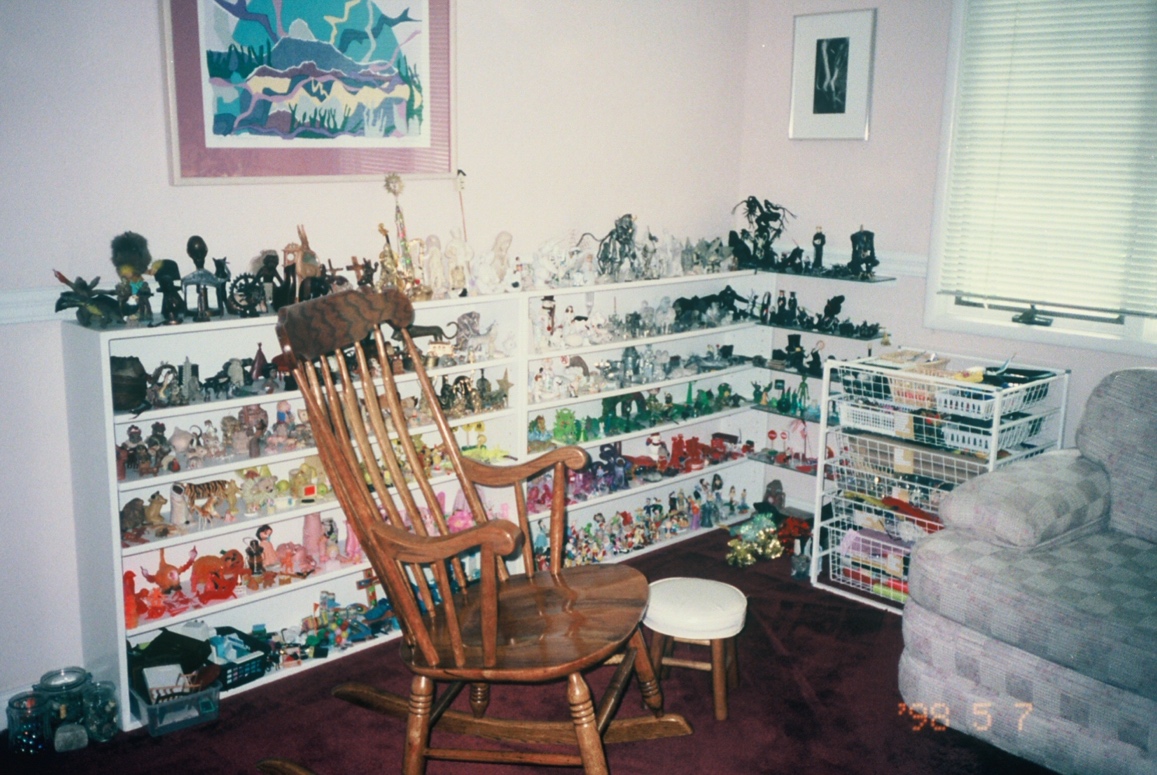
I generally do not screen or discriminate where I place items. One exception is that very breakable ones are put higher up. They are for use by all after a discussion about “using two hands” and care to retrieve them. My arrangement means that what others may consider “archetypal” and “adult” offerings are not set out of children’s direct sight and reach. My goal is to never censor a person’s options, no matter their age. In my decades of Sandtray practice I have observed that people most often find what they need to do their inner work, often ignoring what is placed nearby on a shelf.

